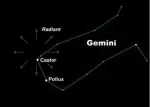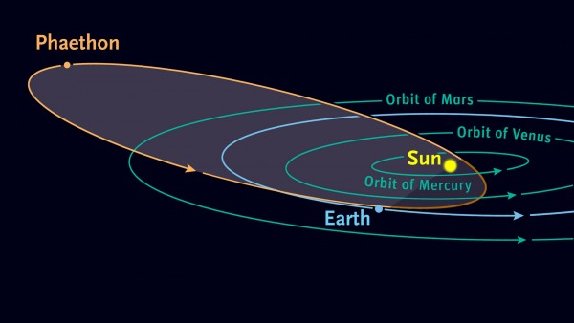Dec 13, 2016

We’re hoping for some excellent viewing of the Geminid meteors in 2016, despite the overpowering moonlight this year. The shower starts around the second week in December and since these meteors are known for being bright, some Geminid meteors may well overcome this year’s moonlit glare! The peak night of the 2016 Geminid meteor shower is December 13 (evening of December 13 until dawn December 14). The nights before and after might be good as well. Geminid meteors tend to be few and far between at early evening, but intensify in number as evening deepens into late night. In an uncanny bit of bad timing, The full moon will shine all night long on the peak night (December 13-15). Geminid meteors are bright, so we expect to see some despite the moonlit glare! This shower favors Earth’s Northern Hemisphere, but it’s visible from the Southern Hemisphere, too. Follow the links below to learn more about the Geminid meteor shower in 2016.
The Geminid meteors radiate from a point near the star Castor in Gemini.
How to watch the Geminid meteors in 2016. The December Geminids are a particularly reliable and prolific shower, one of the finest of the year. In 2016, the peak night could be the night of December 13 (morning of December 14). Try the nights before and after, too, anywhere from about the evening of December 12 to the morning of December 15.
You need no special equipment – just a dark, open sky and maybe a sleeping bag to keep warm. Plan to sprawl back in a hammock, lawn chair, pile of hay or blanket on the ground. Lie down in comfort, and look upward.
Your local peak will typically be centered at about 2 a.m. local time, no matter where you are on the globe. That’s because the constellation Gemini – radiant point of the shower – will reach its highest point for the night around 2 a.m. (your local time). As a general rule, the higher the constellation Gemini climbs into your sky, the more Geminid meteors you’re likely to see.
Some people mistakenly think that, since meteor showers have radiant points, you should look in the direction of the shower’s radiant point to see the most meteors. Not so! The meteors will appear in all parts of the sky. It’s even possible to have your back to the constellation Gemini and see a Geminid meteor fly by. However, if you trace the path of a Geminid meteor backwards, it appears to originate from the direction of the constellation Gemini.
Quite by coincidence, the dazzling planet Jupiter will rise in the east at about the same time that the Geminid radiant climbs highest up for the night: around 2 a.m. So count upon Jupiter, the sole visible planet in the December 2016 morning sky, to keep you good company from about 2 a.m. until dawn!
It’s fun to bring along a buddy. Then two of you can watch in different directions. When someone sees one, they can call out “meteor!” This technique will let you see more meteors than one person watching alone will see.
Be sure to give yourself at least an hour of observing time. It takes about 20 minutes for your eyes to adapt to the dark.
Be aware that meteors often come in spurts, interspersed by lulls.
An earthgrazer meteor possible at early evening.You won’t see as many Geminid meteors when the constellation Gemini sits close to the eastern horizon during the evening hours. As night passes, the Geminid’s radiant will climb upward, so that the meteors will be raining down from a point that’s higher in the sky.
Even so, the evening hours are the best time to try to catch an earthgrazer meteor.
Earthgrazers are rarely seen but prove to be especially memorable, if you should be lucky enough to catch one. An earthgrazer is a slow-moving, long-lasting meteor that travels horizontally across the sky.
Why are these meteors called the Geminids? If you trace the paths of the Geminid meteors backward, they all seem to radiate from the constellation Gemini, hence the reason for the meteor shower’s name.
In fact, the radiant point of this meteor shower nearly coincides with the bright starCastor. However, the radiant point and the star Castor just happen to be a chance alignment, as Castor lies about 52light-yearsaway while these meteors burn up in the upper atmosphere, some 100 kilometers (60 miles) above the Earth’s surface.
You don’t need to find the constellation Gemini to watch the Geminid meteor shower. These medium-speed meteors streak the nighttime in many different directions and in front of numerous age-old constellations. It’s even possible to see a Geminid meteor when looking directly away from the shower’s radiant point. However, if you trace the path of any Geminid meteor backward, it’ll lead you back to theconstellation Gemini the Twins.
Orbit of Asteroid 3200 Phaethon, parent of the Geminid meteor shower

Orbital path of 3200 Phaethon, viaskyandtelescope.com
What causes the Geminid meteor shower?Every year, in December, our planet Earth crosses the orbital path of asteroid 3200 Phaethon, a mysterious body that is sometimes referred to as a rock comet.
In periods of 1.43 years, this small 5-kilometer (3-mile) wide asteroid-type object swings extremely close to the sun (to within one-third of Mercury’s distance), at which juncture intense thermal fracturing causes this rocky body to crack and crumble, and to shed rubble into its orbital stream. Annually, at this time of year, the debris from 3200 Phaethon crashes into Earth’s upper atmosphere at some 130,000 kilometers (80,000 miles) per hour, to vaporize as colorful Geminid meteors.
Bottom line: Reliable Geminid shower ahead! The shower is typically best around 2 a.m. when the radiant point – in the constellation Gemini – is highest in the sky. This year, the full moon will interfere, but we expect some of the brighter Geminids to make an appearance all the same. Try watching anywhere from the evening of December 12 to the morning of December 15. Night of December 13 (morning of December 14) probably the peak. This post contains information about the shower’s radiant point, and more tips on when and how to watch December’s Geminid meteor shower.
Image: The Geminid meteors radiatefrom a point near the star Castor in Gemini
Share this article with friends!
Tags:
#Geminid#Meteor#Shower,#meteors,#december#geminid#meteors,#astrolgoy,#starzpsychics.com,#starz#advisors


